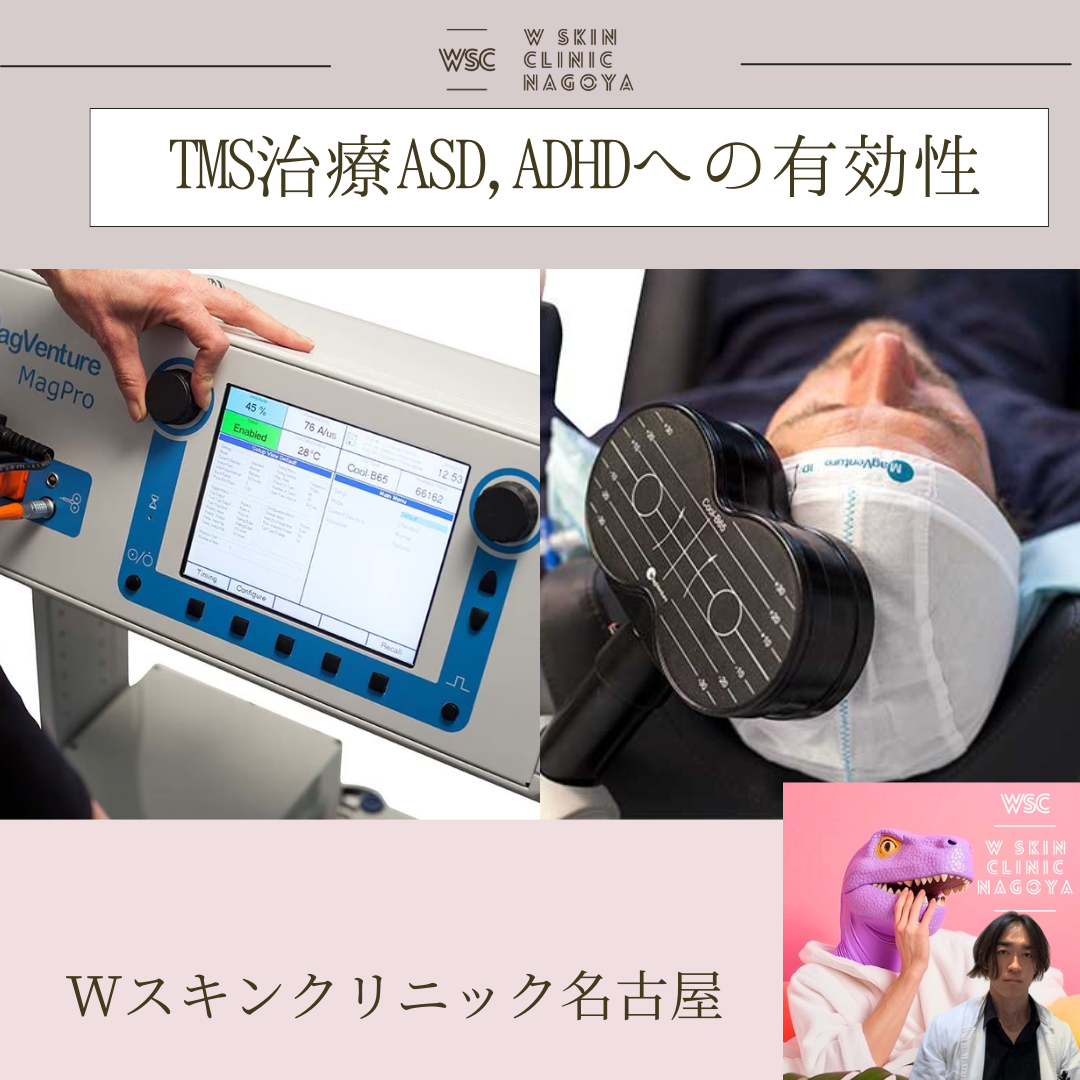NEWSお知らせ
2024.09.16|ブログ
TMS治療はASD、ADHDに対して有効か?その根拠は?、名古屋の美容皮膚科医が解説

TMS治療はASD、ADHDに対して有効か?その根拠は?、名古屋の美容皮膚科医が解説
こんにちは、Wスキンクリニック名古屋、院長の加藤晃司です。
今回は、TMS治療はASD、ADHDに対して有効か?その根拠は?について解説します。
経頭蓋磁気刺激(TMS)治療は、非侵襲的に脳に磁気パルスを送る治療法で、主にうつ病の治療で知られていますが、近年では**自閉スペクトラム症(ASD)や注意欠陥・多動性障害(ADHD)にも応用されています。これらの神経発達障害に対して、TMS治療がどのように有効であるか、そしてその根拠について詳しく説明します。
- TMS治療のメカニズム
TMS(Transcranial Magnetic Stimulation)は、頭皮に磁気コイルを置き、特定の脳の領域に短時間の磁気パルスを送ることで、神経活動を一時的に変化させる治療法です。特に、前頭前野やその他の脳の領域に刺激を与えることで、神経回路の再編成や機能の正常化を促進するとされています。
- ASD(自閉スペクトラム症)に対するTMSの有効性
①根拠とメカニズム
ASDの特徴には、社会的コミュニケーションの障害や反復的な行動、感覚過敏などがあります。これらは、脳の特定の領域、特に前頭前野やミラーニューロン系の異常な活動に関連していると考えられています。
TMS治療では、これらの領域に磁気パルスを当てることで、神経活動を調整し、ASD症状の改善を試みます。特に、社会的認知機能や感情制御に関連する領域に作用させることで、コミュニケーション能力の向上や感覚過敏の軽減を目指します。
②臨床的な研究
一部の臨床研究では、**反復性TMS(rTMS)**をASDの患者に対して適用したところ、社会的認知機能の改善や、感覚過敏、反復的行動の軽減が報告されています。
具体的には、右側の下前頭回にTMSを適用することで、社会的コミュニケーションやミラーニューロン系の機能が改善される可能性が示唆されています。
まとめ(ASDに対する有効性)
TMS治療は、ASDに関連する脳領域の異常な神経活動を調整することで、社会的コミュニケーションや感覚過敏などの症状に対して改善が期待されています。
- ADHD(注意欠陥・多動性障害)に対するTMSの有効性
①根拠とメカニズム
ADHDの特徴には、不注意、多動性、衝動性が含まれます。これらは、特に前頭前野を含む脳のいくつかの領域の神経活動が過度に低下していることが原因の一部と考えられています。
TMS治療では、前頭前野に磁気パルスを当てて、この領域の神経活動を活性化することを目指します。特に、右側の前頭前野の調整が、不注意や集中力の改善に役立つと考えられています。
②臨床的な研究
一部の研究では、ADHDの患者に対してrTMSを適用した結果、不注意、多動性、衝動性の軽減が報告されています。TMSによる神経活動の調整が、集中力の向上や、衝動的な行動の抑制に寄与したとされています。
具体的には、左前頭前野にTMSを適用することで、前頭前野の活性化が促進され、ADHDの特徴的な症状が改善するという結果が見られています。
他の研究でも、プラセボ対照試験でTMSを使用した場合、プラセボ群に比べてADHD症状が有意に改善したという報告があります。
まとめ(ADHDに対する有効性)
ADHDに対するTMS治療は、前頭前野の神経活動を活性化させることで、集中力や衝動性の改善に効果を示す可能性があります。初期の臨床研究では、一定の有効性が示されています。
- 結論
TMS治療の有効性とその根拠
ASDに対しては、TMS治療が社会的認知機能や感覚過敏の改善に効果を示す可能性があります。
ADHDに対しては、TMS治療が不注意や衝動性、多動性の改善に寄与するというエビデンスが蓄積されています。
しかしこれらは海外の研究報告の結果であり、日本での実臨床でのデータはまだまだ不足しています。
当法人では20歳未満へのTMS治療症例、ASDやADHDへのTMS治療症例を数多く経験しています。
一定の効果を認めており、今後データ解析し、論文として発表していきます。
Wスキンクリニック名古屋での、TMS治療はこちら
https://www.w-clinic-nagoya.com/tms
現在TMS治療のモニター募集しております。
ご興味のある方は、クリニックまでお問い合わせください。
Wスキンクリニック名古屋
理事長 加藤晃司
当院では無料でスタッフカウンセリングを行なっております。
お気軽にご予約くださいませ
Wスキンクリニック名古屋 (美容皮膚科)
https://www.w-clinic-nagoya.com/
〒461-0005 愛知県名古屋市東区東桜 2-4-1 第3コジマビル6F
TEL 052-7377-7117(10:00~19:00)
LINE ID @w.nagoya
高岳駅より徒歩4分 / 新栄町駅より徒歩5分
お車でお越しの方
名鉄協商パーキングチケットをお渡しいたしますので、クリニック近くのパーキングをご利用ください。
Is TMS Treatment Effective for ASD and ADHD? Explanation by a Cosmetic Dermatologist in Nagoya
Hello, I’m Dr. Koji Kato, the director of W Skin Clinic Nagoya.
Today, I would like to discuss whether TMS treatment is effective for ASD (Autism Spectrum Disorder) and ADHD (Attention Deficit Hyperactivity Disorder), and the evidence supporting this.
Transcranial Magnetic Stimulation (TMS) is a non-invasive treatment that delivers magnetic pulses to the brain. It is mainly known for its effectiveness in treating depression, but in recent years, it has also been applied to neurodevelopmental disorders like ASD and ADHD. I will explain how TMS treatment can be effective for these disorders and provide supporting evidence.
- Mechanism of TMS Treatment
TMS (Transcranial Magnetic Stimulation) works by placing a magnetic coil on the scalp and delivering short magnetic pulses to specific regions of the brain. This treatment temporarily alters neural activity, particularly in areas like the prefrontal cortex, which can help rewire neural circuits and normalize brain function.
- Effectiveness of TMS for ASD (Autism Spectrum Disorder)
① Evidence and Mechanism
ASD is characterized by challenges in social communication, repetitive behaviors, and sensory hypersensitivity. These symptoms are thought to be related to abnormal activity in specific brain regions, especially the prefrontal cortex and the mirror neuron system.
TMS aims to modulate neural activity in these areas to improve symptoms associated with ASD. By targeting regions related to social cognition and emotional regulation, TMS may help enhance communication skills and reduce sensory sensitivities.
② Clinical Studies
Some clinical studies have applied repetitive TMS (rTMS) to patients with ASD, reporting improvements in social cognition, sensory hypersensitivity, and reduced repetitive behaviors. For instance, applying TMS to the right inferior frontal gyrus has shown potential in improving social communication and mirror neuron system function.
Summary (Effectiveness for ASD) TMS treatment shows promise in adjusting abnormal neural activity in brain regions associated with ASD, potentially improving social communication and sensory sensitivity.
- Effectiveness of TMS for ADHD (Attention Deficit Hyperactivity Disorder)
① Evidence and Mechanism
ADHD is characterized by symptoms such as inattention, hyperactivity, and impulsivity, which are believed to be partly caused by underactive neural activity in certain brain regions, particularly the prefrontal cortex.
TMS targets the prefrontal cortex with magnetic pulses to stimulate neural activity in these areas, aiming to improve inattention and focus. Adjusting activity in the right prefrontal cortex is thought to help with concentration and attention regulation.
② Clinical Studies
Some studies have applied rTMS to ADHD patients, reporting reductions in inattention, hyperactivity, and impulsivity. The modulation of neural activity through TMS has been found to contribute to improved concentration and reduced impulsive behavior.
In particular, applying TMS to the left prefrontal cortex has been shown to activate this region and improve core ADHD symptoms. Other studies, including placebo-controlled trials, have shown significant improvement in ADHD symptoms in TMS groups compared to placebo groups.
Summary (Effectiveness for ADHD) TMS treatment for ADHD may help activate the prefrontal cortex, improving focus and reducing impulsivity. Early clinical studies have demonstrated some degree of effectiveness.
- Conclusion
Effectiveness and Evidence for TMS Treatment For ASD, TMS treatment shows potential in improving social cognition and sensory sensitivity by modulating abnormal neural activity.
For ADHD, evidence suggests that TMS treatment can contribute to improvements in inattention, impulsivity, and hyperactivity through stimulation of the prefrontal cortex.
However, it is important to note that much of this evidence comes from studies conducted overseas, and clinical data in Japan is still limited.
At our institution, we have extensive experience treating patients under the age of 20 and those with ASD or ADHD using TMS. We have observed certain effects, and we plan to analyze the data further and publish it in a research paper.




